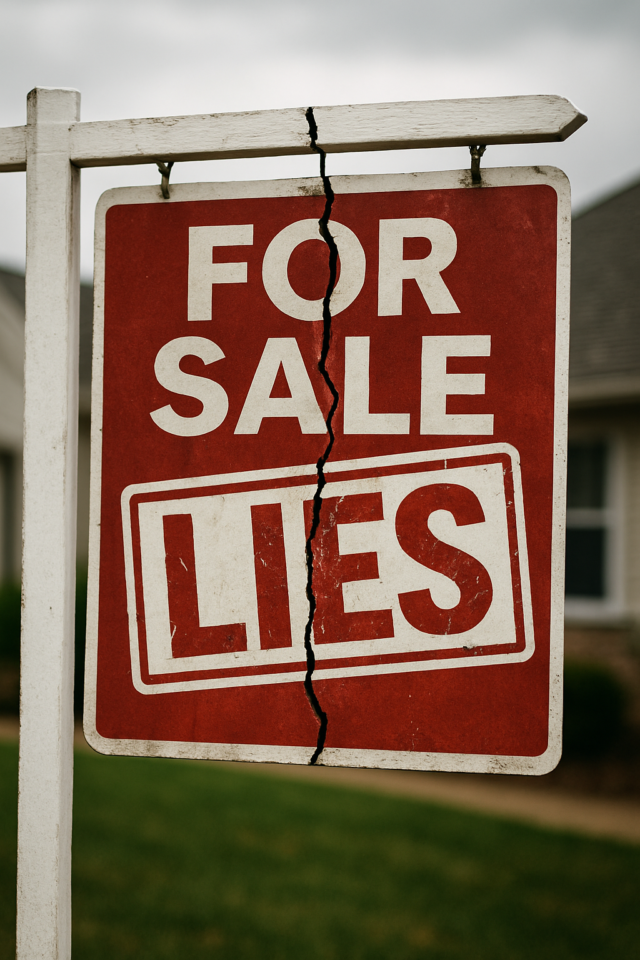The Lies You’ve Been Told About the Housing Market
For decades, the media, so-called experts, and even people in the real estate business have been repeating the same dangerous myths about the housing market. These lies keep investors stuck, scare people out of buying, and trick others into making terrible investment decisions.
After 30+ years of investing through multiple housing booms and busts, I’ve seen firsthand how damaging these lies can be. Today, I’m going to expose the three biggest lies about the housing market—and more importantly, share the truth so you can invest with confidence.

Lie #1: The Market Always Goes Up
This is the most dangerous lie in real estate. People repeat it as if it’s some unshakable law of nature. The truth? Real estate can and does go down.
I’ve seen values drop 30, 40, even 50% in certain markets. In 2008, I bought properties in Texas and Phoenix for less than the cost to build them because banks were desperate to get them off their books.
One of my most memorable deals was a 680-unit building in San Antonio. When I bought it, occupancy was just 30%. We had to pour millions into renovations before it even broke even. But once stabilized, it became a strong cash-flowing asset that lifted the entire neighborhood.
The lesson here is simple: don’t buy a property because you think prices can’t go down. Buy because it cash flows today, because the fundamentals are strong, and because your underwriting is conservative. Appreciation is a bonus, not your bailout plan.
Lie #2: Wait for the Perfect Time to Buy
If you’ve been waiting for “the perfect time,” I’ve got news for you: it doesn’t exist.
In 2008, people said, “Don’t buy—it’s too risky.” In 2012, they said, “Don’t buy! Prices are going up too fast.” In 2020, they said, “Don’t buy! The economy is too uncertain.” If you listened at any of those points, you missed some of the best opportunities of my lifetime.
Back in 2010, Ross and I bought a 28-unit apartment building in what everyone called a “terrible” market. We paid well below replacement cost, about $80,000 a door, and the property cash flowed from day one. It wasn’t perfect. It needed renovations and management fixes. But the fundamentals were strong. Today, that same property is worth over $30 million and has cash-flowed every year since.
The truth is, you don’t make money by perfectly timing the market. You make money by buying good deals that cash flow, then holding them long enough for the cycle to play out.
Lie #3: High Interest Rates Mean You Shouldn’t Buy
This is the one I hear everywhere right now. People think interest rates are too high, so they’re sitting on the sidelines. But here’s the truth: rates are only one piece of the puzzle.
Back in 2009 and 2010, rates were similar to today. Did that stop us from buying? Not at all. In fact, those deals became some of our biggest wins, because the fundamentals were strong. Over time, rates dropped, and we refinanced multiple times, even locking in some debt under 3%.
Here’s what most people miss: high rates often mean less competition. Fewer bidding wars, more negotiating power, and sometimes even lower purchase prices. And if rates eventually drop, you can refinance.
Don’t focus on the interest rate in isolation. Focus on the whole deal: the price, the cash flow, the market fundamentals, and the value-add opportunities.
Final Thoughts: The Truth About Real Estate Success
Let’s recap:
-
Lie #1: The market always goes up → Truth: It can go down. Buy based on today’s numbers, not tomorrow’s hopes.
-
Lie #2: Wait for the perfect time → Truth: There is no perfect time. Buy when the deal makes sense.
-
Lie #3: High interest rates mean don’t buy → Truth: Focus on the whole deal. Rates are only part of the equation.
The real danger in real estate isn’t the market itself—it’s believing the wrong information. If you understand cash flow, buy in markets with strong fundamentals, and structure your deals with safety nets, you can succeed in any market cycle.
Ready to uncover more truths. They’re lying to you about the FED too. I expose the deceit surrounding the FED in this tell-all piece.



